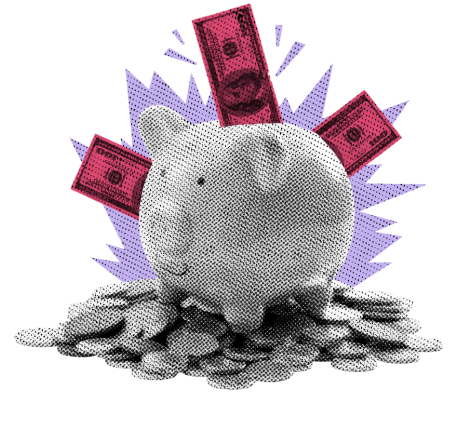High P/Es aren't always red flags–sometimes they’re trail markers.
KEY TAKEAWAYS
-
The P/E ratio is meaningless without context
-
High multiples can be justified if growth expectations are strong
-
Mean reversion doesn't always apply to dominant or innovative firms
-
Comparing a hypergrowth company to an index is poor analysis
-
Companies can shift what is considered “normal” valuation in their sector
MY HOT TAKES
-
Don’t compare cheetahs to cocker spaniels
-
High multiples are only scary if you don’t understand growth
-
Valuation is forward-looking–and sometimes forever-looking–anything goes
-
Some stocks earn the right to be expensive
-
The market sets the value–but it doesn’t mean it’s right–but that doesn’t mean it’s wrong either.
-
You can quote me: “If a company is dominating its market, that premium isn’t expensive–it’s deserved.”
Average Joe / Average Jane. Do you want to simply be… average? Well, I suppose in some areas, being average is OK, but as hungry humans, we will always strive for more… or less, depending on what we are talking about. Taller than average: YES. Smarter than average: HELL YEAH! Heavier than average: certainly not–unless you are a Sumo wrestler. Portfolio returns? I won’t even answer that, because I have run out of expletives that can be safely used in my PG-13 blog/newsletter. How about financial risk in your portfolio? That would be less than average, for sure. The problem, as you probably know, is that it is very hard to have a portfolio that does better than average while simultaneously having less than average risk. That is sort of the basis for modern portfolio theory, but that is not what I want to talk about today.
I had a very nice conversation with one of my favorite Bloomberg journalists yesterday. We were discussing earnings and expected earnings of some very controversial tech stocks. Both were trading at nosebleed multiples. We wondered together how anyone could justify owning stocks that are trading SO much richer than the market and their peers. When I say high multiples, I mean like 280 times forward earnings. **See if you can guess which company we were talking about–drop me an email with your guess.
Let’s think about that multiple for a second. First of all, a multiple on its own MEANS ABSOLUTELY NOTHING. On its own, it only tells you that the stock’s price is 280 times more than the stock's earnings per share (EPS). Does it really matter? No–that’s the short answer. But, the P/E ratio can be a good heuristic gauge of relative value when comparing it to an index or its peers. For example, if all the company’s competitors trade with an average forward P/E of 39 times, well, that implies something.
Looking at P/E in that lens allows us to make the following statement: the stock in question is trading richer than its peers based on P/E. If you really want to get technical, you can also say that the company’s peers are either cheaper than it, or that all its peers stink and deserve to be cheaper.
Many folks–even professional portfolio managers–use this comparative analysis to assess stocks. They may say something like: “that stock is so rich, I wouldn’t touch it,” or “that stock has gotten ahead of itself and it is going to fall.” The logic behind those assertions is what we call on Wall Street mean reversion. Simply defined, mean reversion in P/E ratios refers to a stock’s valuation returning to the average or median of its peer group. If a company trades far above or below its industry, investors often expect its P/E to move closer to peers over time unless strong fundamentals justify the difference. In other words, investors expect a stock with a relatively high P/E to either fall, or underperform its competitors.
So, then, back to my discussion with the Bloomberg journalist. How can anyone buy a company with such hot multiples? Well, if you look back at my definition above ☝️, you would see that I strategically inserted the qualifier “unless strong fundamentals justify.” To understand that, we must first understand how P/E works. If we calculate it simply, you can look up what analysts expect a company’s forward (end of year) earnings per share (EPS) is, and divide the current stock price by it.
That forward EPS is based on, presumably, some company guidance along with an industry analyst’s educated guess on how much better or worse the company will actually do. We typically look at a median of analysts’ projections. Remember, that forward EPS may be yearend, or even next year, but that’s it. Step back for a second. Is a stock only worth what its EPS is going to be at the end of this year? Of course, not. A stock’s price should represent all the known information about the underlying company. That includes future expected earnings–all of them–forever.
To assess that, we have to think about the company’s target market. Is it growing fast, providing lots of revenue opportunities? Does the company have a big penetration in that market? Can the company maintain its market share? Can the company ward off competitors from taking market share? Finally, can a company leverage its resources to find new opportunities and expand beyond its currently addressable market?
If you can answer ‘yes’ to all those questions, it is fair to assume that the company should be valuable. Exactly how valuable is the BIG question. How do we know? The answer is simple. By applying the efficient market hypothesis theory (EMH), we know that it's reflected in the stock’s price. In other words, the market is the ultimate arbiter of a stock's value. If you agree with that, the next question should be, is the market’s assessment correct?
Unfortunately, that is where we run out of answers, because only time will tell. So, getting back to the P/E multiple. If the ‘P’ is really high because everyone–the market–expects great things for the company in the near and far future. If that P/E is far greater than its peers, the market may believe that it is in a unique position to dominate and continue to dominate in a rapidly expanding market. If the P/E is greater than it was in the past, perhaps it is simply in a better position to take advantage of the opportunity than it was in the past. Perhaps, the addressable market is new, or proving to be far bigger than was understood in the past.
Imagine if someone made a statement like “this stock is trading at 41 times earnings when the market’s P/E is 25 times, making it extremely expensive.” Knowing what you now know, you might even be offended if someone offered you such a silly comparison. If we say market, we mean a broad index like the S&P 500, we would be comparing a company to an average of 500 other companies, all focused on different markets with different circumstances. In other words, it's not a legitimate comparison. It would be like comparing my dog Eloise’s top running speed to those of all other four-legged animals. She is pretty fast when it comes to chasing rabbits and crunchy treats, but it would not be fair to compare her to a greyhound or a cheetah.
I know that my regular followers would never do something like that. 😉 But let’s say someone offered you a more realistic assessment, saying that a company’s “P/E is richer than its peer group.” Can we assume that the “rich” company will revert to the mean of its peers?
I think that you should know by now that the answer is “not necessarily”. In that case, the stock isn’t reverting to the mean because it may be redefining where the mean should be! Certain companies, by consistently outperforming on growth, profitability, or innovation, can shift the baseline for what investors view as “normal” within a peer group. Over time, their elevated multiples become the new benchmark, not the exception. When enough investors believe a premium is deserved and durable, that premium stops looking expensive–it starts looking standard.
If you are satisfied with average, you can simply accept stocks that have average future prospects. You can buy stocks with average, or “normal” P/E multiples. But if you believe there are stocks that will redefine what normal will be, their high multiples become… well, meaningless. Now knowing this, you may want to have a closer look at that stock with the high multiple, because it may be justifiable. To be clear, it doesn’t always work out, but it can, and when it does, you typically end up with… well, greater than average returns.
YESTERDAY’S MARKETS
Stocks rallied yesterday after the President offered hope in the form of tariff relief to tech high-flyer Apple in return for an investment in the US, implying that the same may be more broadly applied. Tech liked that, which means that the large-cap indexes liked that–sorry small-caps.


.png)

